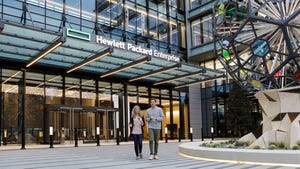BT demos ‘hyperfast’ broadband, ‘pre-standard 5G’ and SDN for live videoBT demos ‘hyperfast’ broadband, ‘pre-standard 5G’ and SDN for live video
UK operator BT has been showing off the latest inventions at its Adastral Park labs, with a focus on fixed-line performance.
June 12, 2017

UK operator BT has been showing off the latest inventions at its Adastral Park labs, with a focus on fixed-line performance.
Arguably the headline piece of wizardry is the coining of the term ‘hyperfast’ to describe broadband that’s even faster than ultrafast and loads faster than superfast. In this case we’re talking about test equipment designed to replicate a real-life FTTP connection, which managed to yield a data rate of no less than 100 Gbps. It was developed in partnership with Huawei.
BT seems to think this demo is a big deal and is claiming it on behalf of Openreach, despite the two being legally separate or something like that. “This is the first time this has been demonstrated in public, and because we’re using standard infrastructure we can show exactly how we‘d transmit data to a customer’s premises, said Mark Lam, CIO of Openreach.
“It demonstrates a massive hike in speed – the highest we’ve seen worldwide. In fact it’s so fast that it’s actually very hard to transmit anything over it that can properly illustrate the capacity. It would pump more bandwidth into your home than the TV broadcasters use to transmit their raw footage from a football match.”
Another BT offshoot – EE – also got in on the telecoms Aladdin’s cave action, claiming to be the first UK operator to demonstrate pre-standard 5G backhaul. This involved using 26 GHz spectrum to backhaul mini mobile sites attached to helium balloons that can be used to provide emergency coverage in a similar fashion to the Google Loon concept. EE’s version is called Helikite.
“The EE network will go from strength to strength thanks to BT’s incredible R&D capabilities and our commitment to delivering what our customers need,” said Marc Allera, EE CEO. “Today’s demonstration is a great example of that: we know that we need better solutions to keep customers connected in the most rural parts of the UK and during disasters, and we can make that solution even more powerful by developing ground breaking pre-standard 5G technology.”
A trail that BT was happy to claim for itself was the ‘broadcast network of the future’, which took the form of a software-defined network that can be used to transmit multiple uncompressed HD video streams via HD pipes, thus dramatically removing the amount of on-site equipment needed to cover remote events. The technology partners were Cisco and Nevion
“We’re keen to explore how a broadcast infrastructure based on true SDN and related technologies could potentially allow us to build a brand new next generation and multi-tenanted global network in the future in the same way as we led the way on MPLS and IP based media networks previously,” said Mark Wilson-Dunn, VP of BT Media & Broadcast.
Another joint effort with Huawei was the development of a fibre ‘superchannel’, which will presumably be followed by an ultrachannel and a hyperchannel. This is a single-channel core fibre technology that combines multiple 400 Gbps wavelengths to potentially top data rates of 13 Tbps.
Professor Tim Whitley, BT’s MD of Research & Innovation, said: “This trial proves that we can release even more capacity from fibre optic infrastructures by further boosting the efficiency of light transmitted over a single strand of glass,” said Professor Tim Whitley, BT’s MD of Research & Innovation.
“Although there isn’t a need for multi-terabit speeds in the core network just yet, we want to stay ahead of the game and ensure that the core network is ready to support the performance that our customers might demand in the future.”
Lastly BT published some research that found IT Directors aren’t sure what effect AI and that sort of thing will have on the labour market. Apparently opinion is evenly divided over whether greater automation will create or destroy jobs, despite it being easier to assume the latter. Either way the consensus is that it’s going to happen regardless.
About the Author
You May Also Like










.png?width=300&auto=webp&quality=80&disable=upscale)


_1.jpg?width=300&auto=webp&quality=80&disable=upscale)